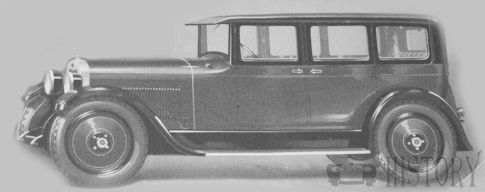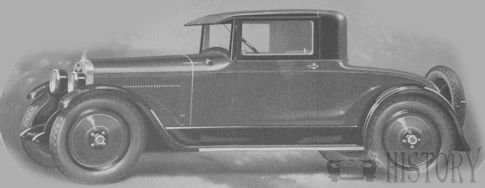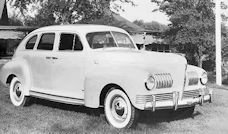Nash Standard Light Six
 | |
Make | Nash |
Production | 1926 to 1929 |
Class | Motor car |
Engine | 2779 cc |
Nash Light Six and Nash Standard Six were passenger car models by Nash Motors from the 1920s. Initially as 5-Passenger Touring, 5-Passenger Four-door Sedan and Coupé.
The Nash Light Six appeared in May 1926. It had the internal model number 220. In principle, it was just a renamed model as a successor to the Ajax from the Ajax Motors Company . The six-cylinder in - line engine with SV valve control and 7 bearing crankshaft , 76.2 mm bore , 101.6 mm stroke and 2779 cc displacementmade 40 bhp (29 kW) at 2400 / min. To the two four-door structures was added a two-door coupe. The expectation of the management, which wanted to increase the sales by renaming the car, was fulfilled: it sold 60% more than in the previous year. The year 1927 brought slightly different body lines, resulting in softer lines. There were no technical changes. New came a two-door sedan and a four-door luxury sedan.
In model year 1928, the Light Six was renamed Standard Six, Model 320 . The engine was drilled to 3017 cc (bore × stroke = 79.4 mm × 101.6 mm) and now made 45 bhp (33 kW) at 2600 / min. The radiator was a little higher and the four-door luxury sedan was replaced by a Landaulet . This was the first time a two-door convertible.
1929, the wheelbase of the model 420 was extended to 2858 mm, the engine power increased at constant displacement to 50 bhp (37 kW) at 2800 / min. The new, even taller and narrower radiator featured a herringbone pattern. In 1930, the new single Six replaced the standard Six and its larger sister model Special Six .
STANDARD EQUIPMENT—All models are equiped with cowl lights, rear-view mirror, automatic windshield wiper, cowl ventilator, air cleaner, Oil purifier, hydrostatic gasoline gauge on instrument board, combination stop and tail lamp, double filament head-lamps, 5 disc wheels with extra wheel mounted on carrier at rear.
Technical details
ENGINE: six-cylinder in - line engine with SV valve control ,
ENGINE TYPE: 2779 cc L head. 3 inch bore and 4 inch stroke. Combined fan and water
PISTONS: Cast iron. 3 rings—2 main and oil regulating.
IGNITION: Automatic spark advance
CLUTCH: Single plate. The clutch release bearing
TRANSMISSION: 3 forward speeds and one reverse.
BRAKES: 12-inch drums on all 4 wheels.
STEERING GEAR: Cam and lever type
FRONT AXLE: Drop-forged steel I-beam; reversed Elliott type.
REAR AXLE: Semi-floating type. Pressed steel housing with removable malleable iron pinion and ring gear carrier.
DRIVE: Rear wheel drive Hotchkiss type,
SPRINGS: Semi-clliptic front and rear. Springs, front 36 inches long. Rear, 50 inches long, 2 inches wide.
FRAME: 4 inches deep, 94 stock. S cross members.
TIRES: 4.75 On 21 inch rims. Full balloon cord tires. Standard 56 inch tread.
POWER: 40 bhp (29 kW)
WHEELBASE: 2946-3073 mm





